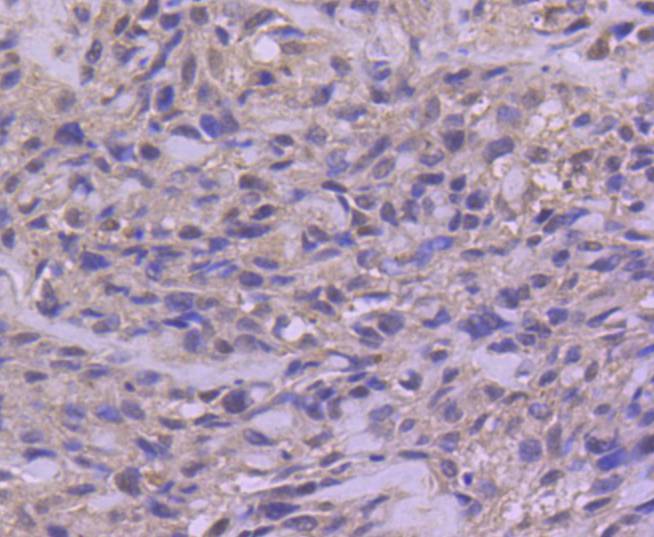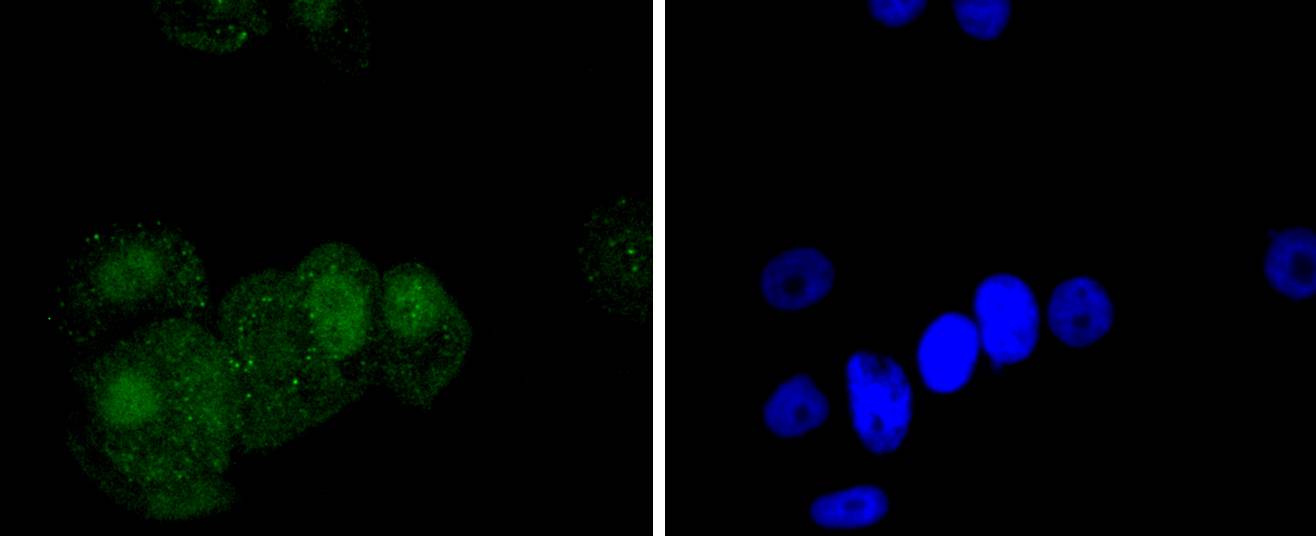Product Detail
Product Namec-Jun(Phospho-S63) Rabbit mAb
Clone No.SY0297
Host SpeciesRabbit
ClonalityMonoclonal
PurificationProA affinity purified
ApplicationsWB, ICC, IHC
Species ReactivityHu, Ms, Rt
Immunogen DescSynthetic phospho-peptide corresponding to residues surrounding Ser63 of human c-Jun.
ConjugateUnconjugated
Other NamesActivator protein 1 antibody
AP 1 antibody
AP1 antibody
cJun antibody
Enhancer Binding Protein AP1 antibody
Jun Activation Domain Binding Protein antibody
JUN antibody
Jun oncogene antibody
JUN protein antibody
Jun proto oncogene antibody
JUN_HUMAN antibody
JUNC antibody
Oncogene JUN antibody
p39 antibody
Proto oncogene c jun antibody
Proto oncogene cJun antibody
Proto-oncogene c-jun antibody
Transcription Factor AP 1 antibody
Transcription factor AP-1 antibody
Transcription Factor AP1 antibody
V jun avian sarcoma virus 17 oncogene homolog antibody
V jun sarcoma virus 17 oncogene homolog (avian) antibody
V jun sarcoma virus 17 oncogene homolog antibody
V-jun avian sarcoma virus 17 oncogene homolog antibody
vJun Avian Sarcoma Virus 17 Oncogene Homolog antibody
Accession NoSwiss-Prot#:P05412
Uniprot
P05412
Gene ID
3725;
Calculated MW40 kDa
Formulation1*TBS (pH7.4), 1%BSA, 40%Glycerol. Preservative: 0.05% Sodium Azide.
StorageStore at -20˚C
Application Details
WB: 1:1,000-1:2,000
IHC: 1:50-1:100
ICC: 1:50-1:200
Western blot analysis of Phospho-c-Jun(S63) on different lysates using anti-Phospho-c-Jun(S63) antibody at 1/1,000 dilution. Positive control:
Lane 1: NIH/3T3
Lane 2: 293T
Immunohistochemical analysis of paraffin-embedded human breast carcinoma tissue using anti-Phospho-c-Jun(S63) antibody. Counter stained with hematoxylin.
Immunohistochemical analysis of paraffin-embedded human tonsil tissue using anti-Phospho-c-Jun(S63) antibody. Counter stained with hematoxylin.
ICC staining Phospho-c-Jun(S63) in PC-3M cells (green). The nuclear counter stain is DAPI (blue). Cells were fixed in paraformaldehyde, permeabilised with 0.25% Triton X100/PBS.
ICC staining Phospho-c-Jun(S63) in MCF-7 cells (green). The nuclear counter stain is DAPI (blue). Cells were fixed in paraformaldehyde, permeabilised with 0.25% Triton X100/PBS.
ICC staining Phospho-c-Jun(S63) in A549 cells (green). The nuclear counter stain is DAPI (blue). Cells were fixed in paraformaldehyde, permeabilised with 0.25% Triton X100/PBS.
Genes belonging to the Jun and Fos oncogene families encode nuclear proteins that are associated with a number of transcriptional complexes. The c-Jun protein is a major component of the transcription factor AP-1, originally shown to mediate phorbol ester tumor promoter (TPA)-induced expression of responsive genes through the TPA-response element (TRE). The Jun proteins form homo- and heterodimers which bind the TRE, while Fos proteins are active only as heterodimers with any of the Jun proteins. Fos/Jun heterodimers have a much higher affinity for the TRE than Jun homodimers. Ha-Ras augments c-Jun activity and stimulates phosphorylation of its activation domain. An inhibitor of Fos/Jun function, termed IP-1, associates with Fos and Jun and is inactivated upon phosphorylation induced by the cAMP-dependent protein kinase A (PKA).
If you have published an article using product 13361, please notify us so that we can cite your literature.
et al,Upregulation of SNTB1 Correlates with Poor Prognosis and Promotes Cell Growth in Colorectal Cancer. In Cancer Cell Int on 2021 Oct 18 by Liya Liu, Youqin Chen,et al..PMID: 34663329
, (2021),
PMID:
34663329
et al,Exploration of the lactation function of protein phosphorylation sites in goat mammary tissues by phosphoproteome analysis
, (2021),
PMID:
34583635








 Yes
Yes



